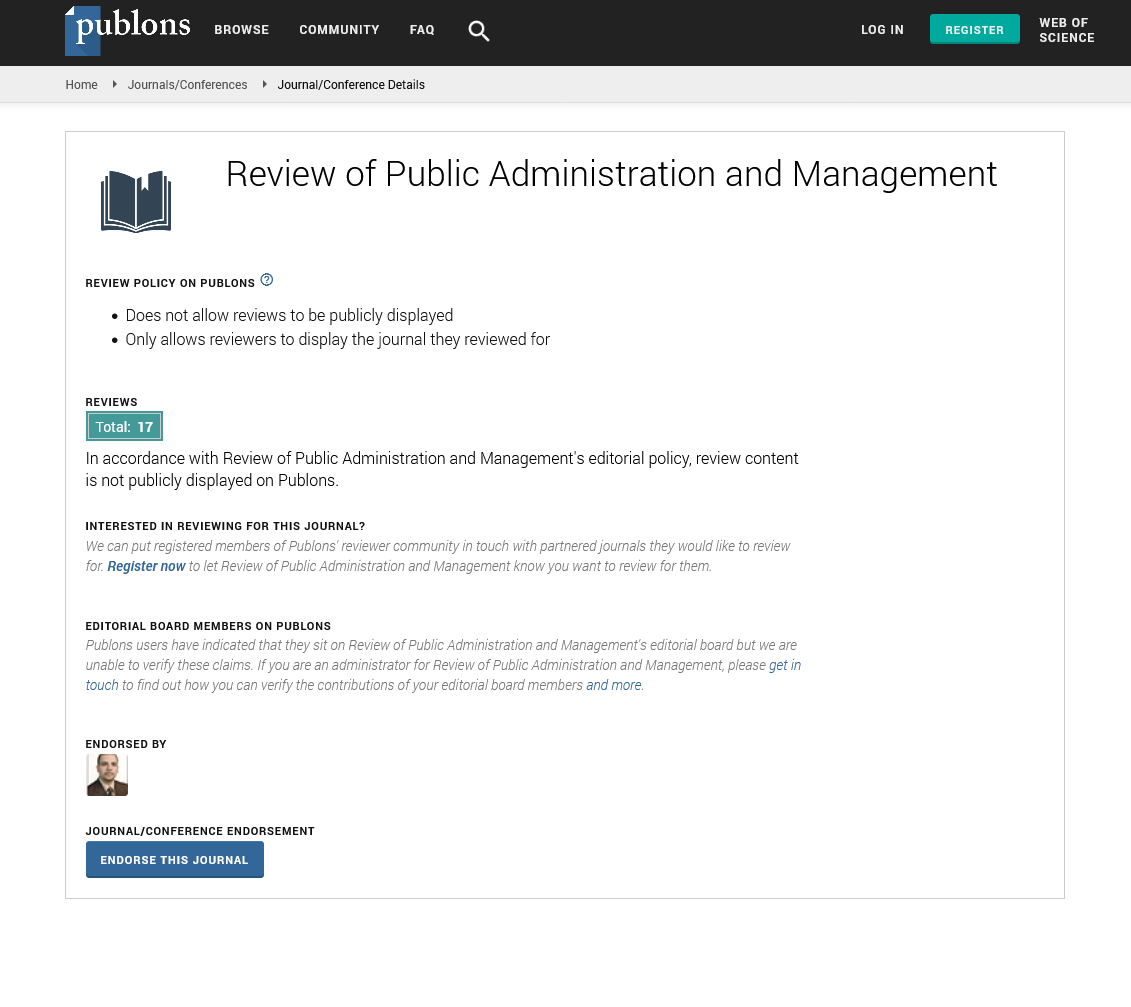Indexed In
- CiteFactor
- RefSeek
- Directory of Research Journal Indexing (DRJI)
- Hamdard University
- EBSCO A-Z
- Scholarsteer
- Publons
- Euro Pub
- Google Scholar
Useful Links
Share This Page
Journal Flyer

Open Access Journals
- Agri and Aquaculture
- Biochemistry
- Bioinformatics & Systems Biology
- Business & Management
- Chemistry
- Clinical Sciences
- Engineering
- Food & Nutrition
- General Science
- Genetics & Molecular Biology
- Immunology & Microbiology
- Medical Sciences
- Neuroscience & Psychology
- Nursing & Health Care
- Pharmaceutical Sciences
Commentary - (2025) Volume 13, Issue 2
Administrative Reforms and Public Trust in Modern Governance
Michael Peterson*Received: 02-Jun-2025, Manuscript No. RPAM-25-29750; Editor assigned: 04-Jun-2025, Pre QC No. RPAM-25-29750; Reviewed: 17-Jun-2025, QC No. RPAM-25-29750; Revised: 21-Jun-2025, Manuscript No. RPAM-25-29750; Published: 28-Jun-2025, DOI: 10.35248/2315-7844.25.13.486
Description
Public administration is often described as the bridge between policy decisions made by political actors and the services received by ordinary citizens. Over the past century the study and practice of public administration have evolved significantly and one of the recurring themes in this evolution is the question of how trust in government institutions can be maintained or restored. Trust is not a static attribute. It ebbs and flows depending on how administrations perform in delivering services, enforcing rules and ensuring fairness. Administrative reforms, therefore, are not merely organizational adjustments but mechanisms through which governments attempt to reshape their relationship with the public. The nature of trust in governance is complex. It is influenced by cultural expectations, historical experiences and socioeconomic conditions. In the United States for example public trust in government reached high points during the mid-twentieth century but steadily declined in later decades, especially after events such as the Vietnam War and the Watergate scandal. Administrative reforms introduced in the 1980s and 1990s under the broad umbrella of New Public Management sought to restore confidence by borrowing tools from private sector management. Efficiency, customer service orientation and performance measurement became dominant themes. Although these reforms achieved notable gains in specific areas such as reducing paperwork and improving service delivery times, critics argued that they sometimes prioritized speed over fairness or accountability.
More recent reforms have recognized that restoring public trust requires more than efficiency. Citizens expect transparency and genuine participation. Digital platforms are one reform avenue that has expanded access to information and services. By enabling citizens to track government spending, file taxes online, or submit feedback through official portals, governments demonstrate openness. In California for instance open data initiatives have allowed non-profits and journalists to monitor spending patterns in real time. This level of visibility reassures the public that mismanagement is less likely to occur behind closed doors. Yet transparency alone does not guarantee trust. If citizens perceive that the information is inaccessible due to technical jargon or overly complicated interfaces, the reform fails in its mission. Cultural change within administrative bodies is equally important. Reforms that restructure agencies or introduce new technologies often overlook the human factor: the attitudes, values and motivations of civil servants. A reform that looks strong on paper may produce minimal results if public officials view it as an additional burden rather than a genuine improvement. Training programs that instill a sense of responsibility toward citizens can help create a service culture. For example, the city of Los Angeles launched programs emphasizing empathy in service delivery, where employees are reminded that their actions directly affect real people’s lives. Such initiatives may seem symbolic, but they contribute to long-term trust building by humanizing administration.
International comparisons illustrate that reforms tailored to local contexts tend to perform better. In Scandinavian countries, administrative reforms have historically emphasized participatory democracy and egalitarian access. Citizens are invited to consultations and local governments act with high levels of autonomy. This approach resonates with social expectations in those societies. In contrast, in countries with centralized traditions, reforms often emphasize efficiency and discipline. What matters is not the uniformity of reforms but their alignment with cultural expectations. Trust is not a universal formula; it is the product of context-specific interactions between institutions and people. Another dimension of administrative reforms concerns accountability mechanisms. Independent auditing agencies, parliamentary oversight committees and ombudsman offices are designed to monitor government actions and address complaints. Reforms that strengthen these institutions can reassure citizens that misconduct will not go unchecked. The success of such mechanisms, however, depends on their independence and credibility. If oversight bodies are perceived as politically influenced, they may do little to restore trust. In the US Government Accountability Office, for instance, credibility has been built over decades of non-partisan investigation. Such examples show that accountability, when institutionalized effectively, plays a major role in shaping public perceptions.
Critics of administrative reforms often highlight their short-term orientation. Governments sometimes introduce reforms to respond to immediate crises or public dissatisfaction, only to abandon them once political pressures ease. Trust, however, develops over time. Citizens evaluate administrations not only on isolated successes but on consistency. A one-time reform that improves transparency for a year will not sustain trust unless it becomes embedded in everyday practice. Therefore, reforms should be viewed not as temporary fixes but as ongoing commitments. Finally, reforms must also address inclusiveness. If reforms disproportionately benefit certain groups while neglecting marginalized populations, they risk deepening social divides and eroding trust further. Inclusive reforms are those that ensure accessibility for people with disabilities, affordability for low-income groups and cultural sensitivity for diverse communities. In Los Angeles for instance multilingual service options have been introduced in public offices, allowing non-English speakers to interact with agencies without barriers. Such measures demonstrate that administration acknowledges and respects the diversity of its citizens.
In conclusion, administrative reforms represent both opportunities and challenges in the effort to restore public trust. Technical efficiency, transparency, cultural change, accountability, consistency and inclusiveness are all interlinked dimensions. No single reform can guarantee trust, but a sustained commitment across these dimensions can gradually rebuild confidence. Citizens ultimately judge their governments not on rhetoric but on everyday experiences with administration. Reforms that improve those experiences in tangible ways are the ones most likely to succeed in strengthening the fragile yet essential bond of trust between state and society.
Citation: Peterson M (2025). Administrative Reforms and Public Trust in Modern Governance. 13:486.
Copyright: © 2025 Peterson M. This is an open-access article distributed under the terms of the Creative Commons Attribution License, which permits unrestricted use, distribution and reproduction in any medium, provided the original author and source are credited.


